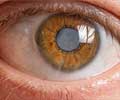Researchers identify the first gene associated with the formation of age-related cataracts, a leading cause of blindness.
Researchers identify the first gene associated with the formation of age-related cataracts, a leading cause of blindness.
Bing-Cheng Wang, Ph.D., Case Western Reserve University School of Medicine professor of pharmacology and senior staff scientist at MetroHealth Medical Center, and Sudha K. Iyengar, Ph.D. professor of genetic and molecular epidemiology at Case Western Reserve University School of Medicine, made the discovery.Their research is part of a large-scale collaborative investigation involving 10 different laboratories from the United States, United Kingdom and Australia.
The study, entitled "EphA2is associated with age-related cortical cataract in mice and humans," will be published in the July 31 issue of PLoS Genetics.
Age-Related Cataract or ARC is known to be highly heritable, yet even after decades of research, little is known about the genetic causes for ARC.
The lens of the eye is normally clear, allowing the transmission of focused light onto the retina. Cataracts occur when proteins in the lens become damaged and clump together - causing the lens to become cloudy and obscure vision. Researchers say EphA2 encodes an enzyme which plays a role in the repair of those damaged proteins.
Expression of the EphA2 protein occurs naturally in human and mice.
Advertisement
When EPHA2 is absent, unphosphorylated proteins accumulate that indicate high levels of cellular stress.
Advertisement
Source-ANI
ARU









